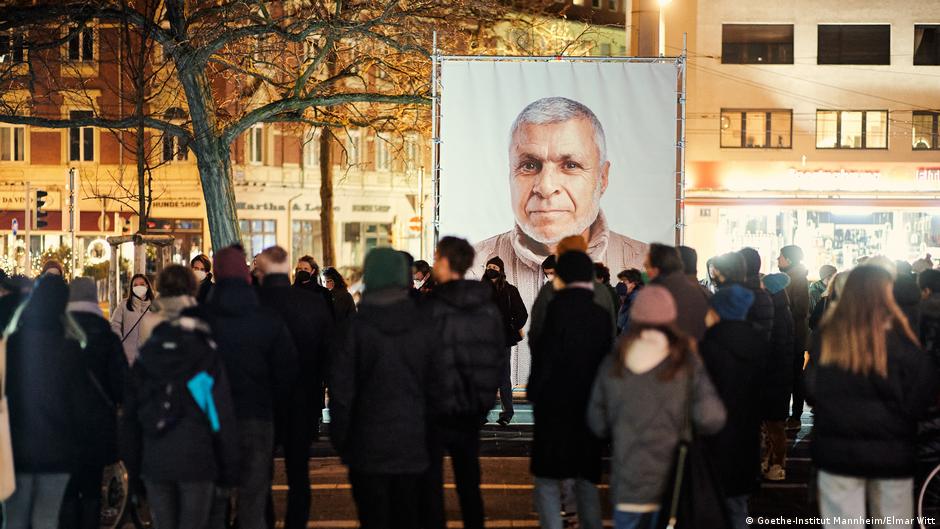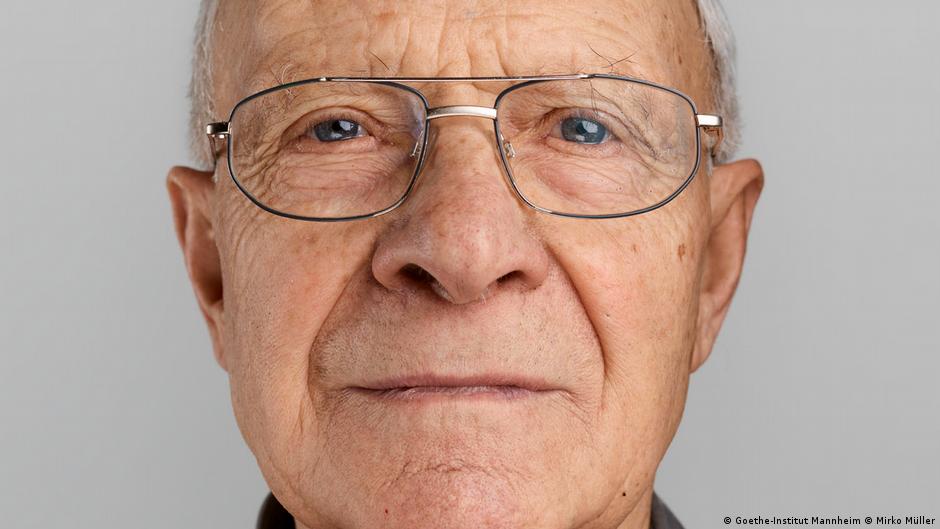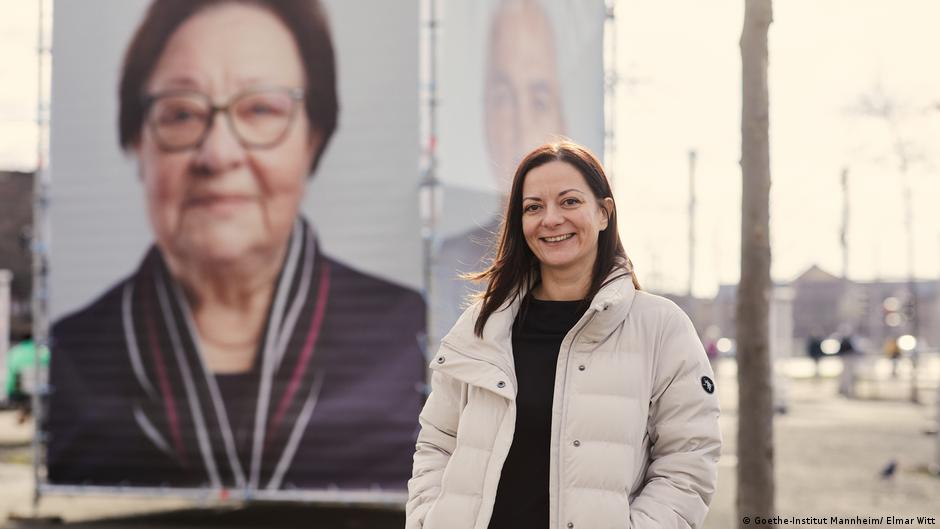How "guest workers" made Germany a country of immigration

Who were the men and women who left their home countries, helped build the economic miracle of West Germany – and received far too little recognition for far too long? Photographer Mirko Müller dedicated himself to this question. Between 2018 and 2021, he took more than 100 portraits of former "guest workers" who arrived in the Federal Republic of Germany as migrant workers from 1955 onwards, collected objects from their lives and wrote down their stories. Much of this can now be seen as part of the exhibition "Vom Kommen, Gehen und Bleiben" (Of Coming, Going and Staying), put together by the Center for International Cultural Education at the Goethe-Institut Mannheim.
Eighteen larger-than-life portrait photos are displayed at central locations in the southwestern German industrial city, where more than 170 nations live together today. Visitors can access video interviews with the protagonists via QR code and cell phone as well as at the Goethe-Institut itself. "The point is to make the people, life stories and individual fates behind the anonymous label 'guest worker' visible," explains project manager Bonka von Bredow. Because the exhibition clearly shows that there is no such thing as a "guest worker.
The term "guest worker" not only describes the expectation of West German society in the 1950s, 60s, 70s and 80s that migrant workers would return to their countries of origin after a certain period of time – the vast majority of "guest workers" shared the same perspective. When the German government concluded the first recruitment agreement with Italy in 1955, few thought that many would nevertheless decide to stay, bring their families with them and thus become pioneers of the modern immigration country, the Federal Republic of Germany.
Until then, refugees from the communist-controlled eastern part of Germany, the GDR, had satisfied the West German industry's need for labour. But over the course of the 1950s, the flow towards the West steadily slowed and with the building of the Berlin Wall in 1961, it stopped altogether. The resulting shortfall in the labour market was filled by two million Italian migrant workers, among others.

From farm labourer to the VW works council
One of them was the young Lorenzo Annese, a farm labourer from Alberobello in southern Italy. In 1958, after health checks in Bari and Verona, he travelled by train via Munich to Bokensdorf near Wolfsburg. There he was to work on a farm together with his brother, who was already in Germany. The two were housed in an attic room with a leaky ceiling, no toilet and no running water – precarious living conditions, as the exhibition also makes clear, were part of everyday life for many "guest workers". Nevertheless, Annese remembers his beginning in West Germany fondly – among other things, because on the very second day he met the nurse he married nine years later.
To escape working in the village, the farm labourer set out to find a new job. "My goal was to start at Volkswagen in Wolfsburg. I had applied many times, but always been rejected. So I decided to take matters into my own hands: I went on a plant tour in 1961 as a visitor. During the tour, I broke away from the group and found the personnel department. By chance, the department head department came around the corner. I explained my situation to him and he simply told me that I could start immediately," Annese recalls.
An ambivalent life plan
Four years later he was elected to the works council. He stayed there until 1993. "It was a difficult job, especially because of the many legal paragraphs, not to mention the bureaucracy. But I pushed through because I wanted to help other people. I know from my past what it's like to have no one to talk to – I didn't want anyone else to feel like that."

"Coming, going and staying – the title reflects the ambivalent life plan of many 'guest workers', which often did not involve staying in Germany," says photographer Mirko Muller. The "guest workers" not only came, many also left. By the time a "recruitment stop" triggered by the oil crisis came into force on 23 November 1973, some 500,000 of a total of 867,000 Turkish labour migrants had already returned to their country of origin. Indeed, for many migrant workers, the thought of leaving was ever-present.
"I always wanted to return"
Take the case of Carmen Morante from Spain. At 22, the woman from a good family followed her husband, a humble tailor, to Germany in 1964. "After two years I slowly began to feel at home. We had settled in, but we only meant to stay until we had enough money together to buy a house in Granada. But we didn't end up leaving after all. I have always wanted to go back, Germany is just not my thing," admits Morante.
"I never actually decided to go to Germany," says Hizir Oymak, who arrived in 1972. "But the village community got together and decided to send me over. I was 15 or 16 years old at the time. Why did I decide to stay? If I had returned to Turkey, I am sure everyone would have asked me if I had been kicked out," says Oymak. His story is representative of that of many other "guest workers" whose coming, going and staying was influenced by the pressure and expectations of friends and family.

Two homes
For people like Hizir Oymak, staying in Germany was closely linked to their concept of home: "I once talked to our mayor in Mannheim about this topic. I told him that our hearts beat twice: when we are in Germany, they beat for Germany, and when we think of Turkey, they beat for Turkey. I say it honestly, I would not want to give up either country. For me, Germany and Turkey are both my home."
Two homes, two hearts – many of Muller's portrait subjects describe their attitude to life in similar terms. "We have to learn that it is not just about paying tribute to the work of these people, but about seeing them as part of our society. Without them, reconstruction and the economic miracle would not have been possible. And contrary to what populist and racist voices would have us believe, they identify very strongly with Germany," concludes project director Bonka von Bredow.
Migration background a recurring theme
Hizir Oymak is not the only one with two hearts beating in his chest. Lorenzo Annese also says: "If you ask me about my home country, I am torn: materially speaking, I don't lack anything in Germany, yet I sometimes miss the warmth. People here are simply not quite as open and approachable as in Italy. Every now and then I wish people in Germany would reach out to each other a little more. But despite everything, I would never return to Italy to live."
And Ljubica Mitrovic, who at 18 followed her husband from Serbia, then a constituent republic of Yugoslavia, to West Germany, has a similar take: "This country is my home now. But Serbia is still my home too. I am happy to have two homes. I have to give the Germans a lot of credit for giving everyone a fair chance. If you want to make a difference here, you can. It's just a pity that people always want to talk about my migration background. It never stops. I suppose my name gives it away."
Christopher Nehring
© Deutsche Welle/Qantara.de 2022